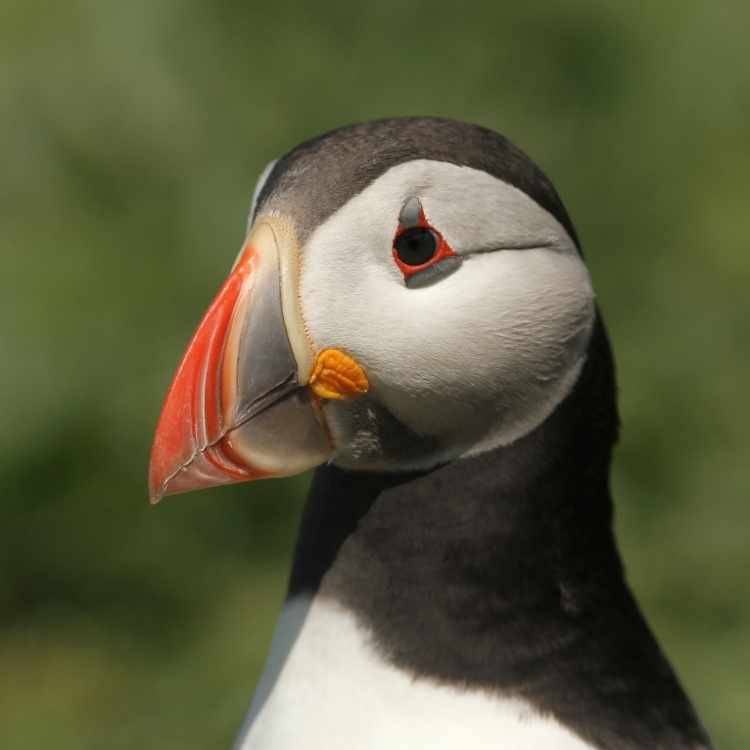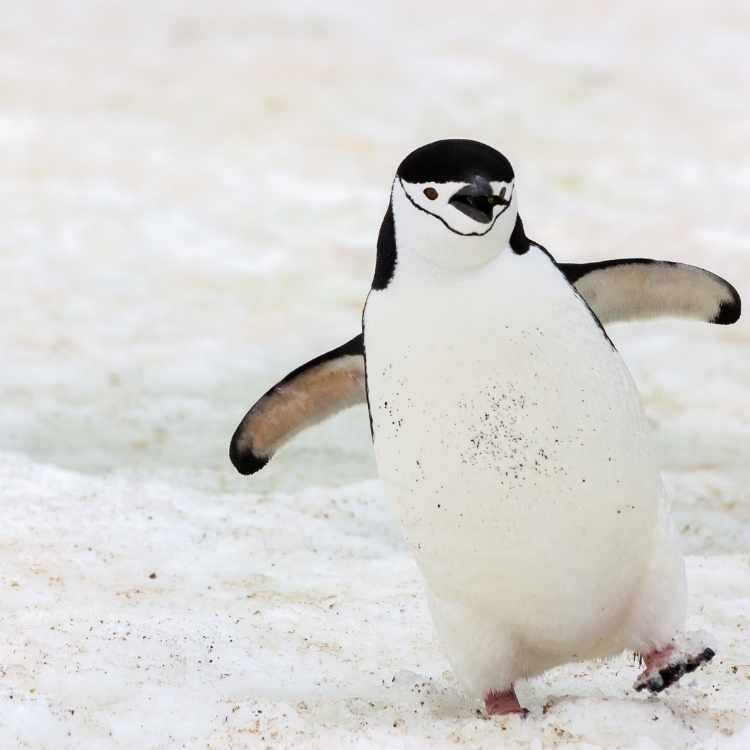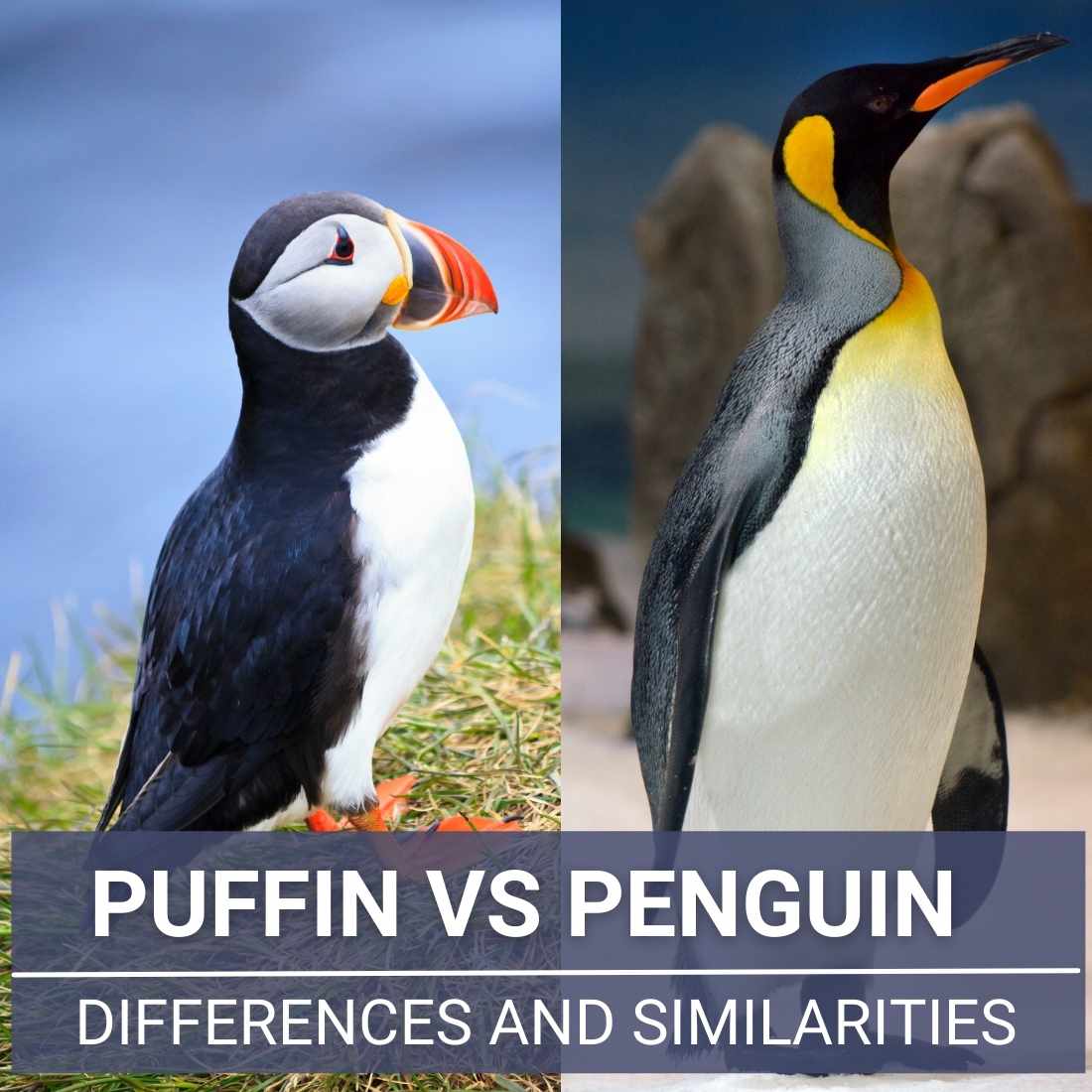In this post, we are talking all about Puffin vs. Penguin. We all know that they sure look similar at first glance (especially to children), so we don’t blame you for confusing the two, but puffins and penguins are quite different species.
Table of Contents
Another thing to remember before moving further is that penguins and puffins aren’t siblings or even cousins, and they do not have any genetic relationship.
Let’s learn about the difference between puffins and penguins, along with all the Penguins and puffins similarities.
Differences Between Puffins and Penguins
| Puffins | Penguins |
|---|---|
| Puffins are members of the Alcidae family, which also contains other bird species such as murres and auklets. | Penguins are members of the well-known Spheniscidae family, which comprises only penguins (all 18 species). |
| Puffins have four unique species: the Atlantic, Horned, Tufted, and Rhinoceros Auklet. | Penguin species include the following: Emperor, African, Chinstrap, Adelie, Erect-crested, Gentoo, Fiordland, Galapagos, Humboldt, King, Macaroni, Northern Rockhopper, Yellow-eyed, Southern Rockhopper, Little Blue, Royal, Snares, and Magellanic. |
| Puffins have the ability to fly. Their bones are hollow, as are the bones of most birds, which allows them to fly for a long time without becoming exhausted. Puffins have also been known to reach speeds of up to 50 miles per hour in bursts! | Penguins are flightless birds. Even though they have what seem to be wings on their bodies (which many people find unexpected, are actually flippers), their solid bones make their tapered (fusiform) bodies too bulky for flight. Still, they are less buoyant and proficient swimmers. When they are on land, their webbed feet assist them in walking on land, and when the conditions are appropriate, they utilize their bodies to fast glide on snow. |
| Puffins spend their maximum life in the water, so they are excellent swimmers. They drive themselves through the water using their wings, while their feet serve as a rudder to keep them on course. | Penguins are the greatest swimmers. They use their flaps for diving and swimming. |
| When completely mature, they grow to be between 12 and 15 inches in height, which is smaller than penguins. You could easily tote a puffin around for a day since they weigh a little more than a pound (0.5 kilograms). | The species vary greatly in size and form, with some varieties reaching maximum heights of 14-16 inches and others standing closer to four feet in height. It is estimated that the weight of an emperor penguin is around 66.5 pounds (30 kilograms). |
| Puffins are found only on rocky shores in the Northern Hemisphere, including the Olympic Coast, Greater Farallones, Stellwagen Bank national marine sanctuaries, and Iceland (with around 60% of the world’s puffin population residing in Iceland). | Penguins live entirely in the Southern Hemisphere, including Australia, the Galapagos Islands, South Africa, Antarctica, and coastal South America. |

Puffin & penguin: similarities
Let’s have a quick look at all the similarities between Penguins and Puffins.
It is a well-known fact that both Puffins and Penguins spend most of their life on the water, although they mate and interact on land. Similarly, both these species eat small fish, shrimp, crab, and squid.
Another similarity between these two bird species is that they have similar patterns of black and white feather coloring and brightly-colored beaks, leading many of us to assume that they are related genetically (but they are not, as mentioned above).
Other similarities include the following
- Penguins and Puffins share a similar breeding pattern, i.e., females lay one or two eggs per year, with both parents actively participating in the incubation and protection of the eggs. The majority of penguins will remain with their partners for their whole lives, whereas puffins will return to the same lair/location each year to rejoin with the same partner.
- Both face dangers caused by people, including bycatch, predators’ introduction, chemical and physical pollution, overfishing, and climate change — particularly for penguins that dwell in the Antarctic and rely on sea ice for access to food and nesting grounds.
Why do penguins have wings if they are unable to fly?
Penguins’ wings function as underwater flippers, allowing them to dive hundreds of feet below the sea’s surface to catch prey. This is an advantageous feature because penguins mostly eat fish and tiny crustaceans. During seasonal migrations, penguins swim instead of flying like their feathered counterparts, allowing them to travel long distances.

Interesting facts about Penguins
The most interesting point about penguins is that the male partner of this species presents rocks to their females to win their affection. It is a very unique feature and only present in them. Along with that, you must be amused to learn that the raft of penguins in the water is referred to as a waddle, while on land, they are referred to as a waddle!
Other facts include the following:
- Penguin feet are designed to let them walk over great distances.
- The dense feathers of a penguin aren’t the only thing that keeps this bird warm. A gland is located near the base of the Penguin’s tail that produces waterproof oil. Penguins devote many hours each day to coating their feathers with this oil, which keeps them warm. They pay particular attention to this activity before swimming in the ocean to keep their body at optimal temperatures.
- Penguins might also give Michael Phelps a run for his money, with some of them capable of swimming faster than 20 miles per hour (32 kph).
- Check also our post about the Penguin symbolism
Here you can check all Penguin sounds: https://www.xeno-canto.org/species/Eudyptula-minor or in the video below
Interesting facts about Puffins
Puffins are the only bird on the planet whose beak (or bill) color changes throughout the year. So due to this feature, many people may confuse them with another bird. Another major fact about them is that puffins dive underwater for 20 to 30 seconds at a time, similar to penguins, and propel themselves forward with their wings exactly like penguins.
Other interesting facts about Puffin include the following:
- Iceland is home to more than 60% of the world’s puffins.
- Puffins are carnivores who survive on tiny fish such as herring, hake, and sand eels, among other things.
- While puffins cannot swim as deep as penguins, they can pack a significant amount of fish into their mouths to bring back to their offspring for feeding. The tops of their jaws are studded with microscopic spines that grab fish, allowing a puffin to cram 62 fish into its beak at once, setting a world record in the process.
Here you can check all Puffin sounds: https://www.allaboutbirds.org/guide/Atlantic_Puffin/sounds or from the video below:
So, who will emerge victorious from the battle between Puffins and Penguins?
You can’t really tell which is better when it comes to their fight because they both are totally different, i.e., Penguins cannot fly, but Puffins can; similarly, penguins live in Southern Hemisphere while Puffin lives in Northern Hemisphere. So, it is a draw.



